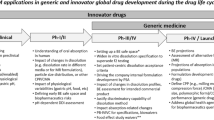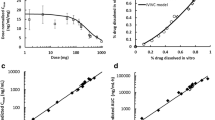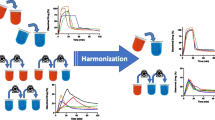Abstract
Dissolution is considered as a critical input into physiologically based biopharmaceutics models (PBBM) as it governs in vivo exposure. Despite many workshops, initiatives by academia, industry, and regulatory, wider practices are followed for dissolution data input into PBBM models. Due to variety of options available for dissolution data input into PBBM models, it is important to understand pros, cons, and best practices while using specific dissolution model. This present article attempts to summarize current understanding of various dissolution models and data inputs in PBBM software’s and aims to discuss practical challenges and ways to overcome such scenarios. Different approaches to incorporate dissolution data for immediate, modified, and delayed release formulations are discussed in detail. Common challenges faced during fitting of z-factor are discussed along with novel approach of dissolution data incorporation using P-PSD model. Ways to incorporate dissolution data for MR formulations using Weibull and IVIVR approaches were portrayed with examples. Strategies to incorporate dissolution data for DR formulations was depicted along with practical aspects. Approaches to generate virtual dissolution profiles, using Weibull function, DDDPlus, and time scaling for defining dissolution safe space, and strategies to generate virtual dissolution profiles for justifying single and multiple dissolution specifications were discussed. Finally, novel ways to integrate dissolution data for complex products such as liposomes, data from complex dissolution systems, importance of precipitation, and bio-predictive ability of QC media for evaluation of CBA’s impact were discussed. Overall, this article aims to provide an easy guide for biopharmaceutics modeling scientist to integrate dissolution data effectively into PBBM models.
Graphical Abstract








Similar content being viewed by others
Abbreviations
- BE:
-
Bioequivalence
- BCS:
-
Biopharmaceutics classification system
- CRDS:
-
Clinically relevant dissolution specifications
- CBA:
-
Critical bioavailability attribute
- CFV:
-
Critical formulation variable
- CMA:
-
Critical material attribute
- CPP:
-
Critical process parameter
- CQA:
-
Critical quality attribute
- DLM:
-
Diffusion layer model
- DDDPlus:
-
Dose disintegration and dissolution plus
- EMA:
-
European Medicines Agency
- GIT:
-
Gastrointestinal tract
- IR:
-
Immediate release
- IVIVC:
-
in vitro in vivo Correlation
- IVIVR:
-
in vitro in vivo Relationship
- MR:
-
Modified release
- TNO TIM:
-
TNO (gastro-) intestinal models
- PSA:
-
Parametric sensitivity analysis
- PSD:
-
Particle size distribution
- PBBM:
-
Physiologically based biopharmaceutics modeling
- P-PSD:
-
Product particle size distribution
- QC:
-
Quality control
- SUPAC:
-
Scale up and post approval changes
- SIVA:
-
Simcyp™ In vitro Data Analysis tool kit
- USFDA:
-
United States Food and Drug Administration
- USP:
-
United States Pharmacopoeia
References
Mitra A, Suarez-Sharp S, Pepin XJH, Flanagan F, Zhao Y, Kotzagiorgis E, et al. Applications of physiologically based biopharmaceutics modeling (PBBM) to support drug product quality: a workshop summary report. J Pharm Sci. 2021;2:594–609. https://doi.org/10.1016/j.xphs.2020.10.059.
Yuvaneshwari K, Kollipara S, Ahmed T, Chachad S. Applications of PBPK/PBBM modeling in generic product development: an industry perspective. J Drug Del Sci Technol. 2022;69:103152. https://doi.org/10.1016/j.jddst.2022.103152.
USFDA guidance for industry. The use of physiologically based pharmacokinetic analyses—biopharmaceutics applications for oral drug product development, manufacturing changes, and controls guidance for industry. Oct 2020. https://www.fda.gov/media/142500/download, Accessed 09th Sep 2022
Gray VA, Mann JC, Barker R, Pepin XJH. The case for physiologically based biopharmaceutics modelling (PBBM): what do dissolution scientists need to know? Dissolution Technol. 2020. https://doi.org/10.14227/DT270320P6
USFDA guidance for industry. Guideline on the reporting of physiologically based pharmacokinetic (PBPK) modelling and simulation. Aug 2018. https://www.ema.europa.eu/en/documents/scientific-guideline/guideline-reporting-physiologically-based-pharmacokinetic-pbpk-modelling-simulation_en.pdf. Accessed 09th Sep 2022
Heimbach T, Suarez-Sharp S, Kakhi M, Holmstock N, Olivares-Morales A, Pepin X, et al. Dissolution and translational modeling strategies toward establishing an in vitro-in vivo link—a workshop summary report. AAPS J. 2019;21(2):29. https://doi.org/10.1208/s12248-019-0298-x.
Jamei M, Abrahamsson B, Brown J, Bevernage J, Bolger MB, Heimbach T, et al. Current status and future opportunities for incorporation of dissolution data in PBPK modeling for pharmaceutical development and regulatory applications: OrBiTo consortium commentary. Eur J Pharm Sci. 2020;155:55–68. https://doi.org/10.1016/j.ejpb.2020.08.005.
Raines K, PBPK biopharmaceutics guidance and progress on risk assessment, in regulatory utility of mechanistic modeling to support alternative bioequivalence approaches workshop 2021. https://www.complexgenerics.org/media/SOP/complexgenerics/pdf/Conference-Slides/D2-04%20Kimberly%20Raines_PBPKGuidanceRiskAssessment.pdf, Accessed 09th Sep 2022.
Wu F, Shah H, Li M, Duan P, Zhao P, Surez S, et al. Biopharmaceutics applications of physiologically based pharmacokinetic absorption modeling and simulation in regulatory submissions to the US Food and Drug Administration for new drugs. AAPS J. 2021;23(2):1–14. https://doi.org/10.1208/s12248-021-00564-2.
Anand O, Clinically relevant dissolution specifications: a biopharmaceutics’ risk based approach: an FDA perspective. 2021. https://www.apsgb.co.uk/wp-content/uploads/2021/05/Clinically-Relevant-Dissolution-Specifications-an-FDA-Perspective-__Om-Anand.pdf. Accessed 09th Sep 2022.
Gray VA, Diaz DA, D’Souza S. Meeting report: dissolution testing, biowaiver, and bioequivalence. Disso Technol. 2020. https://doi.org/10.14227/DT270320P40.
Loisios-Konstantinidis I, Cristofoletti R, Fotaki N, Turner DB, Dressman J. Establishing virtual bioequivalence and clinically relevant specifications using in vitro biorelevant dissolution testing and physiologically-based population pharmacokinetic modeling. case example: naproxen. Eur J Pharm Sci. 2020;143:105170. https://doi.org/10.1016/j.ejps.2019.105170.
Pathak SM. Establishment of virtual bioequivalence using population-based PBPK modelling: application to the setting of dissolution limits. https://www.certara.com/app/uploads/Resources/Posters/Pathak_2015_CRS_dissolution.pdf. Accessed 09th Sep 2022.
Silvia DA, Davies NM, Bou-Chacra N, Ferraz HG, Lobenberg R. Update on gastrointestinal biorelevant media and physiologically relevant dissolution conditions. Dissolution Technol. 2022. https://doi.org/10.14227/DT290222P62.
Kesisoglou F. Approaches for entering dissolution into the absorption model. Current State and Future Expectations of Translational Modeling Strategies to Support Drug Product Development, Manufacturing Changes and Controls Workshop, College Park, MD. https://cersi.umd.edu/sites/cersi.umd.edu/files/Day%202-6%20Filippos%20Kesisoglou.pdf. Accessed 09th Sep 2022.
Pepin X. Approaches to establishing bioequivalence safe space for orally administered drug products: applications & case studies. PQRI BTC 2022 Webinar. Approaches to Establishing Bioequivalence Safe Space for Orally Administered Drug Products: Applications and Case Studies. May 24, 2022. https://pqri.org/wp-content/uploads/2022/05/Presentation-XP-safe-space-24th-May-2022_Final3.pdf. Accessed 09th Sep 2022
Anand O, Pepin XJH, Kolhatkar V, Seo P. The use of physiologically based pharmacokinetic analyses-in biopharmaceutics applications-regulatory and industry perspectives. Pharm Res. 2022;39(8):1681–700. https://doi.org/10.1007/s11095-022-03280-4.
Hermans A, Abend AM, Kesisoglou F, Flanagan T, Cohen MJ, Diaz DA, et al. Approaches for establishing clinically relevant dissolution specifications for immediate release solid oral dosage forms. AAPS J. 2017;19:1537–49. https://doi.org/10.1208/s12248-017-0117-1.
Suarez-Sharp S, Cohen M, Kesisoglou F, Abend A, Marroum P, Delvadia P, et al. Applications of clinically relevant dissolution testing: workshop summary report. AAPS J. 2018;20(6):93. https://doi.org/10.1208/s12248-018-0252-3.
Grady H, Elder D, Webster GK, Mao Y, Lin Y, Flanagan T, et al. Industry’s view on using quality control, biorelevant, and clinically relevant dissolution tests for pharmaceutical development, registration, and commercialization. J Pharm Sci. 2018;107(1):34–41. https://doi.org/10.1016/j.xphs.2017.10.019.
Hofsäss MA, Dressman J. Suitability of the z-factor for dissolution simulation of solid oral dosage forms: potential pitfalls and refinements. J Pharm Sci. 2020;109(9):2735–45. https://doi.org/10.1016/j.xphs.2020.05.019.
Bhattiprolu AK, Kollipara S, Ahmed T, Boddu R, Chachad S. Utility of physiologically based biopharmaeutics modeling (PBBM) in regulatory approval: application to supersede f2, enabling biowaivers & creation of dissolution safe space. J Pharm Sci. 2022. https://doi.org/10.1016/j.xphs.2022.09.003.
Kollipara S, Ahmed T, Bhattiprolu AK, Chachad S. In vitro and in silico biopharmaceutic regulatory guidelines for generic bioequivalence for oral products: comparison among various regulatory agencies. Biopharm Drug Dispos. 2021;42(7):297–318. https://doi.org/10.1002/bdd.2292.
Takano R, Sugano K, Higashida A, Hayashi Y, Machida M, Aso Y, et al. Oral absorption of poorly water-soluble drugs: computer simulation of fraction absorbed in humans from a miniscale dissolution test. Pharm Res. 2006;23:1144–56. https://doi.org/10.1007/s11095-006-0162-4.
Li X, Yang Y, Zhang Y, Wu C, Jiang Q, Wang W, et al. Justification of biowaiver and dissolution rate specifications for piroxicam immediate release products based on physiologically based pharmacokinetic modeling: an in-depth analysis. Mol Pharm. 2019;16(9):3780–90. https://doi.org/10.1021/acs.molpharmaceut.9b00350.
Ding X, Gueorguieva I, Wesley JA, Burns LJ, Coutant CA. Assessment of in vivo clinical product performance of a weak basic drug by integration of in vitro dissolution tests and physiologically based absorption modeling. AAPS J. 2015;17(6):1395–406. https://doi.org/10.1208/s12248-015-9797-6.
Laisney M, Heimbach T, Mueller-Zsigmondy M, Blumenstein L, Costa R, Ji Y. Physiologically based biopharmaceutics modeling to demonstrate virtual bioequivalence and bioequivalence safe-space for ribociclib which has permeation rate-controlled absorption. J Pharm Sci. 2022;111(1):274–84. https://doi.org/10.1016/j.xphs.2021.10.017.
Heimbach T, Kesisoglou F, Novakovic J, Tistaert C, Mueller-Zsigmondy M, Kollipara S, et al. Establishing the bioequivalence safe space for immediate-release oral dosage forms using physiologically based biopharmaceutics modeling (PBBM): case studies. J Pharm Sci. 2021;110(12):3896–906. https://doi.org/10.1016/j.xphs.2021.09.017.
Wu D, Sanghavi M, Kollipara S, Ahmed T, Saini AK, Heimbach T. Physiologically based pharmacokinetics modeling in biopharmaceutics: case studies for establishing the bioequivalence safe space for innovator and generic drugs. Pharm Res. 2022. https://doi.org/10.1007/s11095-022-03319-6.
Moir A, Cole S. Introduction to PBPK/PBBM. How to build a PBBM model and why? Developing clinically relevant dissolution specifications (CRDS) for oral drug products. https://apsgb.co.uk/wp-content/uploads/2021/03/APS-Slides-for-PSO-Webinar-2.pdf. Accessed 23rd Nov 2022
McAllister M, Flanagan T, Cole S, Abend A, Kotzagiorgis E, Limberg J, et al. Developing clinically relevant dissolution specifications (CRDSs) for oral drug products: virtual webinar series. Pharmaceutics. 2022;14(5):1010. https://doi.org/10.3390/pharmaceutics14051010.
Hens B, Seegobin N, Bermejo M, Tsume Y, Clear N, McAllister M, et al. Dissolution challenges associated with the surface pH of drug particles: integration into mechanistic oral absorption modeling. AAPS J. 2022;24(1):17. https://doi.org/10.1208/s12248-021-00663-0.
Pepin XJH, Flanagan TR, Holt DJ, Eidelman A, Treacy D, Rowlings CE. Justification of drug product dissolution rate and drug substance particle size specifications based on absorption PBPK modeling for lesinurad immediate release tablets. Mol Pharm. 2016;13(9):3256–69. https://doi.org/10.1021/acs.molpharmaceut.6b00497.
Pepin XJH, Sanderson NJ, Blanazs A, Grover S, Ingallinera TG, Mann JC. Bridging in vitro dissolution and in vivo exposure for acalabrutinib. Part I. Mechanistic modelling of drug product dissolution to derive a P-PSD for PBPK model input. Eur J Pharm Biopharm. 2019;142:421–34. https://doi.org/10.1016/j.ejpb.2019.07.014.
Cristofoletti R, Hens B, Patel N, Esteban VV, Schmidt S, Dressman J. Integrating drug- and formulation-related properties with gastrointestinal tract variability using a product-specific particle size approach: case example ibuprofen. J Pharm Sci. 2019;108(12):3842–7. https://doi.org/10.1016/j.xphs.2019.09.012.
Pepin X, Goetschy M, Abrahmsén-Alami S. Mechanistic models for USP2 dissolution apparatus, including fluid hydrodynamics and sedimentation. J Pharm Sci. 2022;111(1):185–96. https://doi.org/10.1016/j.xphs.2021.10.006.
Jaiswal S, Ahmed T, Kollipara S, Bhargava M, Chachad S. Development, validation and application of physiologically based biopharmaceutics model to justify the change in dissolution specifications for DRL ABC extended release tablets. Drug Dev Ind Pharm. 2021;47(5):778–89. https://doi.org/10.1080/03639045.2021.1934870.
Papadopoulou V, Kosmidis K, Vlachou M, Macheras P. On the use of the Weibull function for the discernment of drug release mechanisms. Int J Pharm. 2006;309(1–2):44–50. https://doi.org/10.1016/j.ijpharm.2005.10.044.
O’Dwyer PJ, Box KJ, Imanidis G, Vertzoni M, Reppas C. On the usefulness of four in vitro methods in assessing the intraluminal performance of poorly soluble, ionisable compounds in the fasted state. Eur J Pharm Sci. 2022;168:106034. https://doi.org/10.1016/j.ejps.2021.106034.
Zhou D, Chen B, Sharma S, Tang W, Pepin X. Physiologically based absorption modelling to explore the formulation and gastric pH changes on the pharmacokinetics of acalabrutinib. Pharm Res. 2022. https://doi.org/10.1007/s11095-022-03268-0.
Stillhart C, Pepin X, Tistaert C, Good D, Bergh AVD, Parrott N, et al. PBPK absorption modeling: establishing the in vitro–in vivo link—industry perspective. AAPS J. 2019;23(12):19. https://doi.org/10.1208/s12248-019-0292-3.
Pepin XJH, Hammarberg M, Mattinson A, Moir A. Physiologically based biopharmaceutics model for selumetinib food effect investigation and capsule dissolution safe space — part I: adults. Pharm Res. 2022. https://doi.org/10.1007/s11095-022-03339-2.
Mukherjee D, Chiney MS, Shao X, Ju TR, Shebley M, Marroum P. Physiologically based pharmacokinetic modeling and simulations to inform dissolution specifications and clinical relevance of release rates on elagolix exposure. Biopharm Drug Dispos. 2022;43(3):98–107. https://doi.org/10.1002/bdd.2315.
Gomeni R, Bressolle-Gomeni F. Comparison of alternative population modeling approaches for implementing a level A IVIVC and for assessing the time-scaling factor using deconvolution and convolution-based methods. AAPS J. 2020:22. https://doi.org/10.1208/s12248-020-00445-0
McAllister M, Flanagan T, Boon K, Pepin X, Tistaert C, Jamei M, et al. Developing clinically relevant dissolution specifications for oral drug products—industrial and regulatory perspectives. Pharmaceutics. 2020;12(1):19. https://doi.org/10.3390/pharmaceutics12010019.
USFDA Guidance for industry. Dissolution testing of immediate release solid oral dosage forms. August 1997. https://www.fda.gov/media/70936/download#:~:text=For%20NDAs%2C%20the%20dissolution%20specifications,batches%20of%20the%20drug%20product. Accessed 09th Sep 2022
EMA guidance. Reflection paper on the dissolution specification for generic solid oral immediate release products with systemic action. July 2017. https://www.ema.europa.eu/en/documents/scientific-guideline/reflection-paper-dissolution-specification-generic-solid-oral-immediate-release-products-systemic_en.pdf. Accessed 09th Sep 2022
USFDA guidance for industry. Extended release oral dosage forms: development, evaluation, and application of in vitro/in vivo correlations. Aug 2018. https://www.fda.gov/media/70939/download. Accessed 09th Sep 2022
Fiolka T, Dressmann J. Development, current applications and future roles of biorelevant two-stage in vitro testing in drug development. J Pharm Pharmacol. 2018;70(3):335–48. https://doi.org/10.1111/jphp.12875.
Ibrahim F. An enabling formulation of a weakly basic compound guided by physiologically based biopharmaceutics modeling (PBBM). J Pharm Sci. 2022;111(9):2490–5. https://doi.org/10.1016/j.xphs.2022.04.001.
Berben P, Ashworth L, Beato S, Bevernage J, Bruel JL, Butler J, et al. Biorelevant dissolution testing of a weak base: interlaboratory reproducibility and investigation of parameters controlling in vitro precipitation. Eur J Pharm Biopharm. 2019;140:141–8. https://doi.org/10.1016/j.ejpb.2019.04.017.
Luo L, Thakral NK, Schwabe R, Li L, Chen S. Using tiny-TIM dissolution and in silico simulation to accelerate oral product development of a BCS class II compound. AAPS PharmSciTech. 2022;23(6):185. https://doi.org/10.1208/s12249-022-02343-4.
Wu D, Li M. Current state and challenges of physiologically based biopharmaceutics modeling (PBBM) in oral drug product development. Pharm Res. 2022. https://doi.org/10.1007/s11095-022-03373-0.
de León-Ortega RD, D’Arcy DM, Lamprou DA, Fotaki N. In vitro-in vivo relations for the parenteral liposomal formulation of amphotericin B: a clinically relevant approach with PBPK modeling. Eur J Pharm Biopharm. 2020;5:177–87. https://doi.org/10.1016/j.ejpb.2020.03.001.
Zhao L. What is a model master file and how can it be shared? 2021 CRCG PBPK workshop: regulatory utility of mechanistic modeling to support alternative bioequivalence approaches. https://www.complexgenerics.org/media/SOP/complexgenerics/pdf/Conference-Slides/D2-14%20Liang%20Zhao20211001-CRCG%20PBPK%20Workshop%20Final.pdf. Accessed 09th Sep 2022
Zhao L. Potential types of model master files. 2022 CRCG workshop: best practices for utilizing modeling approaches to support generic product development. https://complexgenerics.org/media/SOP/complexgenerics/pdf/best-practices-for-utilizing-modeling-approaches-to-support-generic-product-development-final-agenda.pdf. Accessed 23rd Nov 2022
Acknowledgements
Authors would like to thank Dr. Reddy’s Laboratories Ltd. for providing an opportunity to publish this review article.
Author information
Authors and Affiliations
Contributions
SK — concept and design, writing manuscript; AK — concept and design, writing manuscript; RB — concept and design, writing manuscript; TA — concept and design, manuscript review, approval for version to be published; SC — manuscript review, approval for version to be published.
Corresponding author
Ethics declarations
Conflict of Interest
All the authors are employees of Dr. Reddy’s Laboratory and report no conflicts interest. The authors alone are responsible for the content and writing of this article.
Additional information
Publisher's Note
Springer Nature remains neutral with regard to jurisdictional claims in published maps and institutional affiliations.
Supplementary Information
Below is the link to the electronic supplementary material.
Rights and permissions
Springer Nature or its licensor (e.g. a society or other partner) holds exclusive rights to this article under a publishing agreement with the author(s) or other rightsholder(s); author self-archiving of the accepted manuscript version of this article is solely governed by the terms of such publishing agreement and applicable law.
About this article
Cite this article
Kollipara, S., Bhattiprolu, A.K., Boddu, R. et al. Best Practices for Integration of Dissolution Data into Physiologically Based Biopharmaceutics Models (PBBM): A Biopharmaceutics Modeling Scientist Perspective. AAPS PharmSciTech 24, 59 (2023). https://doi.org/10.1208/s12249-023-02521-y
Received:
Accepted:
Published:
DOI: https://doi.org/10.1208/s12249-023-02521-y




